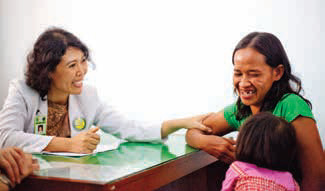Administering antiretroviral therapy (ART) to pregnant
women and then to their infants, and instructing mothers
to avoid breastfeeding in settings where that is safe
and feasible can reduce the risk of mother-to-child HIV
transmission to below one percent. Effective ART can also
ensure that HIV-positive parents will have long, healthy
lives. However, despite these medical advances, a report
by the Asia-Pacifi c Network of People Living with HIV
(APN+) showed that some HIV-positive women are being pushed to have abortions and sterilization
procedures.

A pediatrician
in Indonesia
counsels a
mother about
HIV care for her
daughter.
Their 2011 survey of 757 HIV-positive
women from six countries in South and
Southeast Asia reported abortion rates
between eight percent (Indonesia) and 44
percent (Vietnam). Of the women who
had an abortion, 29 percent indicated that
they were wanted pregnancies. Between
18 percent (Vietnam) and 40 percent
(Indonesia) of the women were asked to
consider sterilization, and 60 percent of
these recommendations came from their
doctors. Juan Mendez, the United Nations
Special Rapporteur on torture and other
cruel, inhuman, or degrading treatment
or punishment, called forced sterilization
of vulnerable communities “an act of
violence… and a violation of the right to be
free from torture and other cruel, inhuman,
or degrading treatment or punishment.”
TREAT Asia recently began working
with the United Nations agencies on HIV
(UNAIDS), development (UNDP), and
children (UNICEF), and APN+ to develop
a coordinated response to prevent forced
abortion and sterilization, and ensure access
to non-stigmatizing reproductive healthcare
for women with HIV in the region. First,
local lawyers will document existing laws
and enforcement mechanisms that protect
sexual and reproductive health rights. The
results will be used to guide subsequent
interventions aimed at improving national
reproductive health policy. Additionally,
the organizations are working to develop
a broader range of activities, including
community trainings on reproductive rights,
and advocacy efforts to improve women’s
access to healthcare in general and to
reproductive health specifically.